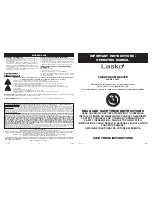
16
© 2023 Breckwell
MAINTENANCE
Remove the ashes periodically to avoid unnecessary ash
build up. Remove ashes when unit has cooled. Ashes
should be placed in a metal container with a tight fitting
lid. The closed container of ashes should be placed on a
noncombustible floor or on the ground, well away from
all combustible materials, pending final disposal. If the
ashes are disposed of by burial in soil or otherwise locally
dispersed, they should be retained in the closed container
until all embers have been thoroughly cooled. The container
shall not be used for other trash or waste disposal. If
combined with combustible substances, ashes and embers
may ignite. Ash removal is as follows:
1. Let the fire burn out and allow the unit to cool to room
temperature.
2. Make sure the pellet stove is at room temperature before
touching. Clean the heat exchanger tubes.
3. Remove the burnpots inner section by grasping it and
pulling straight up.
4. Empty ashes from the inner section and scrape with
cleaning tool; make sure holes are not plugged.
5. Vacuum to remove ashes from the burn chamber interior
and the burnpot shell.
WARNING: Make sure ashes are
cool to the touch before using a vacuum (see “Vacuum
Use”).
6. Dispose of ashes properly (see “Ash Removal”).
7. Replace inner section into burnpot; make sure it is level
and pushed all the way back down and that the igniter
hole is to the rear when it is reinstalled.
8. Make sure the burnpot is level and pushed all the way
in. If the collar on the burnpot, attached to the fresh air
tube, is not pushed back to meet the firebox wall. The
igniter will not work properly.
SMOKE & CO MONITORS
Burning wood naturally produces smoke and carbon
monoxide(CO) emissions. CO is a poisonous gas when
exposed to elevated concentrations for extended periods
of time. While the modern combustion systems in heaters
drastically reduce the amount of CO emitted out the chimney,
exposure to the gases in closed or confined areas can be
dangerous. Make sure you stove gaskets and chimney joints
are in good working order and sealing properly to ensure
unintended exposure. It is recommended that you use both
smoke and CO monitors in areas having the potential to
generate CO.
CHECK & CLEAN THE HOPPER
Check the hopper periodically to determine if there is any
sawdust (fines) that is building up in the feed system or
pellets that are sticking to the hopper surface. Clean as
needed.
DOOR & GLASS GASKETS
Inspect the main door and glass window gaskets periodically.
The main door may need to be removed to have frayed,
broken, or compacted gaskets replaced by your authorized
dealer. This unit’s door uses a 3/4” diameter rope gasket.
BLOWER MOTORS
Clean the air holes on the motors of both the exhaust and
distribution blowers annually. Remove the exhaust blower
from the exhaust duct and clean out the internal fan blades
as part of your fall start-up. If you have indoor pets your
power motors should be inspected monthly to make sure
they are free of animal hair build up. Animal hair build up
in blowers can result in poor performance or unforeseen
safety hazards.
PAINTED SURFACES
Painted surfaces may be wiped down with a damp cloth. If
scratches appear, or you wish to renew your paint, contact
your authorized dealer to obtain a can of suitable high-
temperature paint.
REMOVAL AND REPLACEMENT OF BROKEN
DOOR GLASS
While wearing leather gloves (or any other gloves suitable
for handling broken glass), carefully remove any loose
pieces of glass from the door frame. Dispose of all broken
glass properly. Return the damaged door to your dealer
for repair or replacement. Neither the appliance owner
nor any other unauthorized person(s) should replace the
door glass. An authorized dealer must perform all repairs
involving door glass.
FALL START UP
Prior to starting the first fire of the heating season, check
the outside area around the exhaust and air intake systems
for obstructions. Clean and remove any fly ash from the
exhaust venting system. Clean any screens on the exhaust
system and on the outside air intake pipe. Turn all of the
controls on and make sure that they are working properly.
This is also a good time to give the entire stove a good
cleaning throughout.
SPRING SHUTDOWN
After the last burn in the spring, remove any remaining pellets
from the hopper and the auger feed system. Scoop out the
pellets and then run the auger until the hopper is empty
and pellets stop flowing (this can be done by pressing the
Summary of Contents for SP1000E
Page 2: ...Project 23 114 Model SP1000E Page 2 Revision History 6 14 2023 Original Issue...
Page 11: ...Project 23 114 Model SP1000E Page 11 Appliance Front Appliance Left...
Page 12: ...Project 23 114 Model SP1000E Page 12 Appliance Right Appliance Rear...
Page 14: ...Project 23 114 Model SP1000E Page 14 Pellet Fuel Analysis...
Page 17: ...Project 23 114 Model SP1000E Page 17 Sealed Unit...
Page 60: ......
Page 61: ......
Page 62: ......
Page 113: ...2023 Breckwell 27 ITEMS DEFINED...
Page 181: ......
Page 182: ......
Page 183: ......
Page 184: ......
Page 185: ......
Page 186: ......
Page 187: ......
Page 188: ......
















































